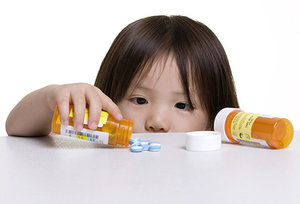Danger Within Reach
By Editorial Staff
Prescription and over-the-counter medications can be dangerous enough even when taken correctly; after all, even the most effective medicine comes with a laundry list of potential side effects, some of which are more health-damaging than the actual condition they're intended to treat.
But what happens when someone takes a medication they don't need to take? And what if that someone is a young child?
Long story short, the consequences can be catastrophic. That's why most medications come with either childproof caps / seals and/or a strict warning to "keep out of reach of children." It seems as if the warnings are going unheeded, with a recent study suggesting unsupervised childhood exposure to medication is shockingly common.
Published in the Journal of Pediatrics, the study evaluated unsupervised solid dose medication exposures by children 5 years and younger based on calls to poison control centers. Among nearly 4,500 participants, 71.6 percent of exposures involved children 2 years or younger, split fairly evenly by prescription medicine exposures, over-the-counter medicine exposures that required child-resistant packaging; and OTC medicine exposures that did not require child-resistant packaging.
 Shockingly, "More than one-half of exposures (51.5%) involving prescription medications involved children accessing medications that had previously been removed from original packaging, compared with 20.8% of exposures involving OTC products. Attention deficit hyperactivity disorder medications (49.3%) and opioids (42.6%) were often not in any container when accessed; anticonvulsants (41.1%), hypoglycemic agents (33.8%), and cardiovascular/antithrombotic agents (30.8%) were often transferred to alternate containers. Grandparents' medications were involved in 30.7% of prescription medication exposures."
Shockingly, "More than one-half of exposures (51.5%) involving prescription medications involved children accessing medications that had previously been removed from original packaging, compared with 20.8% of exposures involving OTC products. Attention deficit hyperactivity disorder medications (49.3%) and opioids (42.6%) were often not in any container when accessed; anticonvulsants (41.1%), hypoglycemic agents (33.8%), and cardiovascular/antithrombotic agents (30.8%) were often transferred to alternate containers. Grandparents' medications were involved in 30.7% of prescription medication exposures."
So, young children are being exposed to dangerous medications because adults are doing the work for them: removing medications from containers that either have child-resistant packaging or packaging that might make a child think twice before messing with (because hopefully, parents have taught them to stay away from medication). In so doing, we're putting their lives at risk.

